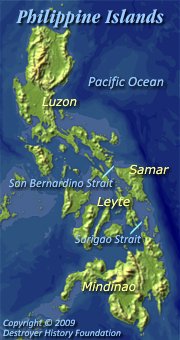

On 20 October 1944, when troops under Gen. Douglas MacArthur landed on Leyte’s east coast to begin reoccupying the Philippines, Japanese naval forces sortied from home waters and from Borneo, intent on forcing their way through the Allied Third and Seventh Fleets to reach the beaches.
On 24 October, while a weak Northern Force approached from the northeast, hoping to lure part of the American fleet away from the main action, a powerful Center Force approached San Bernardino Strait from the west and two elements of a weaker Southern Force approached Surigao Strait.
Temporarily stalled by aircraft attacks (Battle of the Sibuyan Sea), the Center Force passed through San Bernardino Strait in the early hours of 25 October. Meanwhile the Southern Force of two battleships, one cruiser and four destroyers, followed but unsupported by three more cruisers and four more destroyers, passed PT boat pickets without damage and entered Surigao Strait from the south. Tracking them and waiting in ambush were six battleships, eight cruisers and 26 destroyers of Adm. Kinkaid’s Seventh Fleet.
Applying tactics first seen at the Battle of Vella Gulf, three squadrons of destroyers attacked independently in sequence. Two, Destroyer Squadrons 54 and 24, attacked the leading Japanese column from the flanks. The third, Destroyer Squadron 56, then delivered a coup de grâce from ahead in three sections, which were deployed to ensure the enemy would pass “through torpedo waters, no matter which way he turns.”
Overall result: both Japanese battleships and three destroyers were sunk while three cruisers were damaged, at a cost of damage only to DesRon 56’s Albert W. Grant.